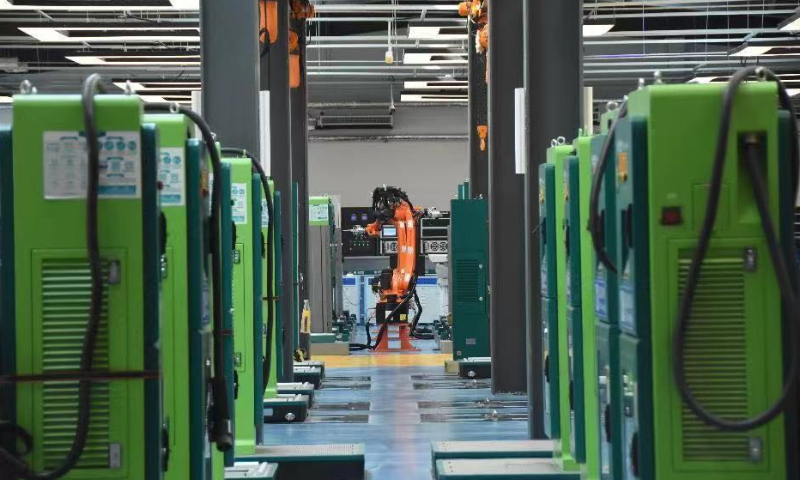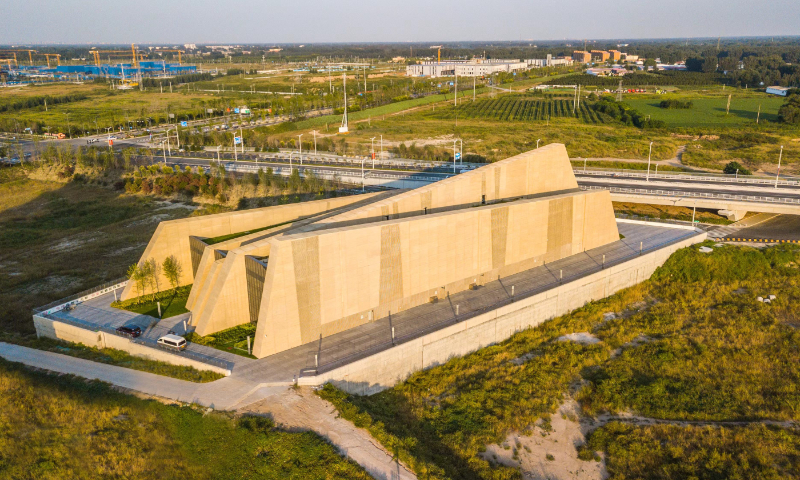
An automated assembly line for electric vehicle (EV) charging piles at the national green development demonstration zone in Tongzhou district, Beijing on February 22, 2024 Photo: Zhang Weilan/GT
Technological innovation has empowered the energy transition and green development of Beijing, which has also had a spillover effect on the Beijing-Tianjin-Hebei (Jing-Jin-Ji) region in North China, the Global Times observed through a visit to the national green development demonstration zone in Tongzhou district, Beijing's sub-city center.
"Advanced" and "well-developed" are apt words for the new types power systems observed by a Global Times reporter who visited the green demonstration zone.
For example, unmanned quality inspections of electric vehicle (EV) charging piles can be realized through assembly lines that are equipped with fully automated robotic arms, which can finish 172 test items.
As the country's first automated verification and testing assembly line for EV charging piles, the testing devices have a maximum power of 900 kilowatts, with a maximum daily testing capacity of 30 units, and the testing efficiency is 90 times higher than the original system, Wang Liyong, chief engineer of the Electric Power Research Institute of State Grid Beijing Electric Power Co, said in an exclusive interview with the Global Times on Friday.
"The
assembly line won special awards at the 48th International Exhibition of Inventions Geneva in 2023, the world's leading annual event devoted exclusively to invention, which showed that China's manufacturing is fully recognized by the world," said Wang.
Cutting-edge technologies and key equipment independently developed by China are going global, Wang said.
The assembly line is part of the new power system experimental base located in the national green development demonstration zone. Covering 3.7 hectares, the laboratory is now a "test field" to boost green and low-carbon development with scientific and technological innovation in Beijing, the Global Times learned.
According to Wang, the experimental base has built a new type of power system featuring a smart distribution network to ensure effective interaction of source-network-load-storage flexible resources, which is empowered by artificial intelligence.
"The new power system can promote accurate matching between supply and demand and ensure reliable power supply," Wang noted.
Building a new type of power system with a smart distribution network is part of the goal of developing new productive forces in the energy and power industry, so as to accelerate talent training and promote industrial development, Wang said.
The new power system has been applied in various areas in Tongzhou, for instance, in the "Green Heart" Park, which is just beside the Grand Canal - a vast waterway system running from Beijing to East China's Zhejiang Province.
There are four newly built switching stations and 11 power distribution rooms in the "Green Heart" Park, enabling power supply reliability in the area to reach 99.9999 percent, Kang Qi, a deputy manager of State Grid Beijing Electric Power Co, told the Global Times on Thursday.
The demonstration base is a prime example of the stepped-up efforts by Tongzhou to realize high-quality development in a green manner, said Kang.
"State Grid Beijing Electric Power Company is dedicated to the construction of a new type of power system that is clean and low-carbon, cost-effective, supply-demand coordinated, flexible and intelligent, so as to promote the clean and low-carbon energy transition in the sub-city center of Beijing," Kang said.
Experts said that the application of the new power system can be widened to the rest of Beijing, and also the Jing-Jin-Ji area.
This year marks the 10th anniversary of the beginning of coordinated development in the Jing-Jin-Ji area. During the past decade, innovation-driven development has led to breakthroughs in green transformation, which have brought a cleaner and greener environment to people in the region.
In 2017, as a further boost to the coordinated development of the region, China announced the establishment of the Xiong'an New Area in North China's Hebei Province, which is meant to be built into a model of green development.
The digitalization of all power substations in the Xiong'an New Area has been completed, the Global Times learned from the local power supply unit of the State Grid during a recent visit to the area.
For example, the 220-kilovolt
Jucun electrical substation is equipped with tech-enabled environmental monitoring devices and digital inspection robotics, which allow operators to make data-driven decisions and proactively address potential issues.

The 220-kilovolt Jucun electrical substation in Xiong'an New Area, North China's Hebei Province, on February 5, 2024 Photo: Zhang Weilan/GT





